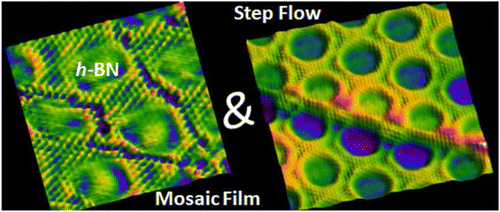| Mike's Pages |
Links |
Step Flow Versus Mosaic Film Growth in Hexagonal Boron Nitride
Jiong Lu, Pei Shan Emmeline Yeo, Yi Zheng, Hai Xu, Chee Kwan Gan, Michael B. Sullivan, A.H. Castro Neto, and Kian Ping Loh
Department of Chemistry, National University of Singapore, 3 Science Drive 3, Singapore 117543,
Graphene Research Centre, National University of Singapore, 6 Science Drive 2, Singapore 117546,
Department of Physics, National University of Singapore, 2 Science Drive 3, Singapore 117542,
Institute of High Performance Computing, 1 Fusionopolis Way, #16-16 Connexis, Singapore 138632
Publication Date (Web): January 17, 2013
J. Am. Chem. Soc., 2013, 135, 2368-2373.

ABSTRACT:
Many emerging applications of hexagonal boron nitride (h-BN) in graphene-based nanoelectronics require high-quality monolayers as the ultrathin dielectric. Here, the nucleation and growth of h-BN monolayer on Ru(0001) surface are investigated using scanning tunneling microscopy with a view toward understanding the process of defect formation on a strongly interacted interface. In contrast to homoelemental bonding in graphene, the heteroelemental nature of h-BN gives rise to growth fronts with elemental polarity. This can have consequences in the different stages of film growth, from the nucleation of h-BN magic clusters and their sintering to form compact triangular islands to the growth of patchwork mosaic monolayer with a high density of misfit boundaries. The parallel alignment of triangular islands on the same terrace produces translational fault lines when growth fronts merge, while antiparallel alignment of islands on adjacent terraces produces non-bonded fault lines between domains terminated by like atoms. With these insights into the generation of void defects and fault lines at grain boundaries, we demonstrate a strategy to obtain high-quality h-BN monolayer film based on step flow growth.
DOI: 10.1021/ja3117735